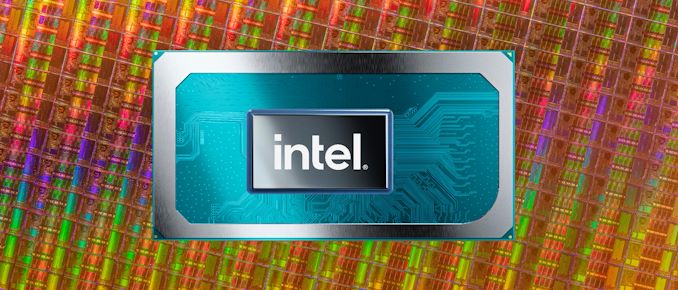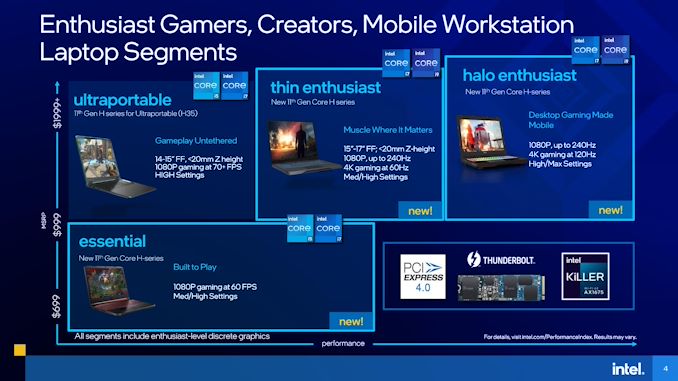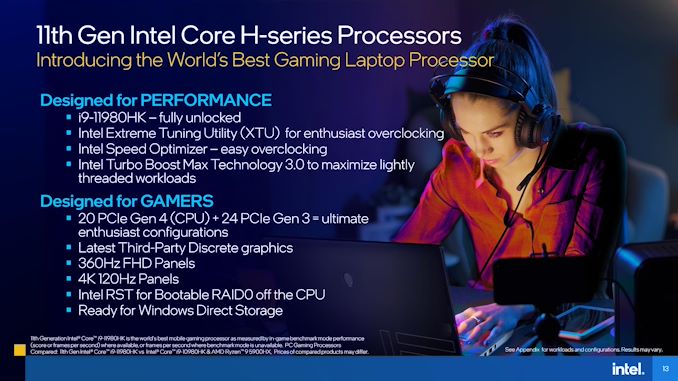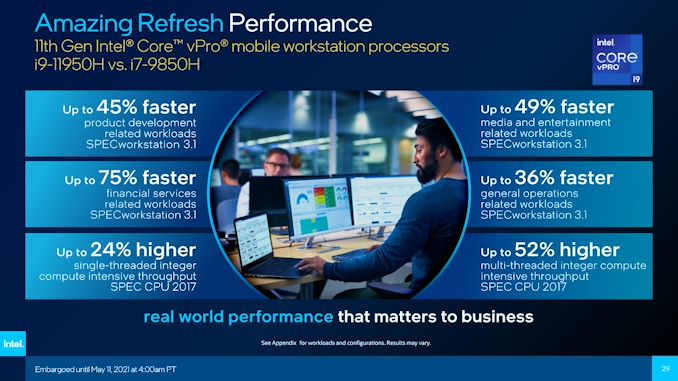Intel Launches 11th Generation Core Tiger Lake-H: Eight Core 10nm Mobile Processors
by Dr. Ian Cutress on May 11, 2021 7:00 AM EST- Posted in
- CPUs
- Intel
- Overclocking
- 10nm
- Xe-LP
- Willow Cove
- Tiger Lake-H
- i9-11980HK
- TGL-H

Ever since the launch of the first series of Intel Core 11th Generation Tiger Lake processors aimed at the ‘U-series’ 15 W market, Intel has teased us that there was another design being produced in the wings. While the Tiger Lake-U was built for portability, battery life, and integrated graphics, the Tiger Lake-H series would double the cores, and be the partner for premium mobile gaming as well as on-the-go muscle. Today is the launch of this new platform, and Intel is promoting over 1 million Tiger Lake-H processors shipped to partners and 80 devices coming to market.
A Quick Recap: Intel Mobile Segmentation
For those who are unfamiliar with Intel’s mobile strategy, it falls into several categories, usually designated by the letter. Over time Intel has been moving around within these categories to define different design points for end-user products, but they have by and large stayed the same. As follows:
| AnandTech | Main TDP |
TDP Range |
Info |
| Y-Series | - | 4-10 W | Novel small form factor Sustained battery life |
| U-Series | 15 W | 12-28 W | 10-14 inch ultraportable Usually reliant on integrated graphics. Some with discrete GPU for portable gaming |
| H35-Series | 35 W | - | New for Tiger Lake. Not actually H, just a high-powered U. |
| H-Series | 45 W | 35-65+ W | 14-17 inch high-performance More cores, discrete graphics 'portable' high-performance gaming Workstation/desktop replacements |
For the new eight-core Tiger Lake-H processors, Intel highlights three key markets:
- Essential: Paired with mid-range GPU, 1080p Gaming at 60 FPS, Medium/High Settings
- Thin Enthusiast: 15+ inch, sub-20 mm, Gaming at 1080p240 or 4K60 at Medium/High
- Halo Enthusiast: 15+ inch, Gaming at 1080p240 or 4K120 at High/Max Settings
The new H-series processors will also have corresponding vPro versions for commercial deployment, and Intel is saying that out of the 80+ designs currently using the new 11th Gen Core Tiger Lake-H, about 15 of them will be vPro focused.
Tiger Lake-H (TGL-H) Processors on Offer
While users might be accustomed to seeing a wide array of Intel processors each differing by the smallest of margins, today’s launch has only five models for consumers, and another five for commercial systems. At the heart are Intel's latest Willow Cove processor cores, with 1.25 MB of exclusive L2 cache, and up to 3 MB of shared L3 cache per core, along with Intel's latest Xe-LP graphics. These all start at six cores and twelve threads, and offer up to 5.0 GHz single-core turbo for the most expensive models.
| Intel Tiger Lake-H Consumer | |||||||||
| AnandTech | Cores Threads |
35W Base |
45W Base |
2C Turbo |
4C Turbo |
nT Turbo |
L3 Cache |
Xe GPU |
Xe MHz |
| i9-11980HK | 8C/16T | - | 2.6 | 5.0* | 4.9 | 4.5 | 24 MB | 32 | 1450 |
| i9-11900H | 8C/16T | 2.1 | 2.5 | 4.9* | 4.8 | 4.4 | 24 MB | 32 | 1450 |
| i7-11800H | 8C/16T | 1.9 | 2.3 | 4.6 | 4.5 | 4.2 | 24 MB | 32 | 1450 |
| i5-11400H | 6C/12T | 2.2 | 2.7 | 4.5 | 4.3 | 4.1 | 12 MB | 32 | 1450 |
| i5-11260H | 6C/12T | 2.1 | 2.6 | 4.4 | 4.2 | 4.0 | 12 MB | 32 | 1400 |
| *Turbo Boost Max 3.0 | |||||||||
The most premium model is the Core i9-11980HK, which looks more akin to a desktop processor! Intel has the eight-core part rated at 2.6 GHz for 45 W, but also lists a base frequency of 3.3 GHz for 65 W. What makes this processor special compared to the others is that it can also be overclocked further than 65 W in systems that allow it. Overclocking on laptops is usually a bit hit and miss, but this is actually the first ever overclockable 10nm processor from Intel. That accolade typically goes to the desktop platform, but this is the first time in recent memory I’ve seen Intel launch an overclockable mobile processor first.
The Core i9-11980HK gets the best of Intel’s design here: 4.5 GHz all-core turbo, 4.9 GHz traditional turbo, and 5.0 GHz with Turbo Boost Max 3.0 on up to two favored cores. The integrated graphics is the base Xe-LP architecture with 32 execution units running at 1450 MHz peak. All processors listed have 32 execution units, with a 350 MHz base and variable peak frequencies.
The other processors here follow Intel’s traditional non-overclocked schema, whereby 45 W is the standard rating and 35 W is the power-down option. The Core i9-11900H for example has Turbo Boost Max 3.0 on two cores up to 4.9 GHz, like the other Core i9, and TBM 3.0 is the main difference down to Core i7 which is also eight-core and sixteen thread.
Compared to Intel’s best TGL-U processors, the Core i7-11375H SE (35W) and the Core i7-1185G7 (28W) are quad-core processors but have much better-integrated graphics.
| Intel Tiger Lake-H Commercial | |||||||||
| AnandTech | Cores Threads |
35W Base |
45W Base |
2C Turbo |
4C Turbo |
nT Turbo |
L3 Cache |
Xe GPU |
Xe MHz |
| W-11955M | 8C/16T | 2.1 | 2.6 | 5.0* | 4.9 | 4.5 | 24 MB | 32 | 1450 |
| i9-11950H | 8C/16T | 2.1 | 2.6 | 5.0* | 4.9 | 4.5 | 24 MB | 32 | 1450 |
| i7-11850H | 8C/16T | 2.1 | 2.5 | 4.8 | 4.8 | 4.3 | 24 MB | 32 | 1450 |
| W-11855M | 6C/12T | 2.6 | 3.2 | 4.8* | 4.7 | 4.4 | 18 MB | 32 | 1450 |
| i5-11500H | 6C/12T | 2.4 | 2.9 | 4.6 | 4.4 | 4.2 | 12 MB | 32 | 1450 |
| *Turbo Boost Max 3.0 | |||||||||
On the commercial front, Intel is mixing up the names between Core and new Xeon W-11000M series processors. There is no overclockable processor here, but the specifications are somewhat identical with 45 W as standard and 35 W optional operating modes. These processors differ because they feature Intel’s vPro, a commercial system allowing for company administration control, Intel Hardware Shield, Total Memory Encryption, and a number of other features to assist deployment across the infrastructure of a business-focused environment. These processors also have ECC memory support, and will defend against cryptocoin mining through detection when used with Microsoft Defender Endpoint.
It is worth noting here that the W-11855M is the odd processor out. It has six cores, but comes with Turbo Boost Max 3.0. It also has 18 MB of L3 cache, the full 3 MB per core, whereas the other 6C processors only have 2 MB per core. I suspect that the W branding is often associated with having as much cores and cache as possible, as in previous generations this has usually been the case.
Tiger Lake-H Silicon and Platform
Compared to the previous Tiger Lake-U silicon, we now get a full eight Willow Cove cores on die, up from four, as well as 20 lanes of PCIe 4.0 for discrete graphics and storage. The overall silicon measures in at around 190 square millimeters, uses Intel’s latest Xe-LP graphics and media engines enabling AV1 decode support, and also has built-in Thunderbolt 4 controllers.
All Tiger Lake-H processors will support DDR4-3200, however it is worth noting that these processors do not support LPDDR4. We expect this to be a more holistic choice that these platforms are not battery life focused, and TGL-H customers prefer having DDR4 as it supports double the capacity (as well as usually being user-replaceable, depending on the design).
The 20 lanes of PCIe 4.0 can be split in three different ways:
- x16 for graphics, x4 for storage
- x8/x8 for graphics, x4 for storage
- x8 for graphics, x4/x4/x4 for storage
In the latter configuration, with up to three PCIe 4.0 x4 storage devices, Intel also supports bootable RAID 0. This is somewhat an obscure configuration, however we have seen MSI desktop-replacement systems come with multi-drive RAID 0 in the past.
The chipset for TGL-H is separate to the CPU, and so there will be a number of mobile chipsets on offer, however Intel has updated the most powerful chipset to a DMI x8 link, offering double the bandwidth back from the chipset to the processor. From the chipset there are another 24 PCIe 3.0 lanes as well as MIPI support for Intel’s Image Processing Unit 6.
Thunderbolt 4 is natively supported, although USB4 is not listed. There is USB 3 support, however Intel fails to list if this is USB 3.2 Gen 1 or Gen 2. For networking, systems can either use a discrete Ethernet controller, or use the chipset integrated Killer AX1675 Wi-Fi 6E solution (if the OEM purchases the corresponding Intel CNVi RF interface). For those of you wondering why Intel is pairing with Killer for the networking here, it’s because Intel acquired the company behind Killer, Rivet Networks, last year for an undisclosed sum.
Intel promotes that TGL-H is ready for Windows Direct Storage, and with appropriate third-party discrete graphics can support the latest 360 Hz 1080p panels or the latest 4K 120 Hz panels. Resizeable BAR is also supported.
Performance
As always with these launches, Intel provides first-party benchmark numbers. We’re loathed to mention any of them, simply because we prefer to validate the claims ourselves.
One thing we can already confirm however is the raw processor improvements: as we saw in previous Tiger Lake systems, Intel offers ‘up to 19%’ better performance per clock over the previous generation. In this comparison, Intel is comparing Tiger Lake-H to Comet Lake-H, which is a derivative of Intel’s 6th Generation architecture. Gains in that market are very much an average of 19%.
But it might be worth noting that comparing against Comet Lake-H is not comparing against Intel’s architectures in chronological order. If we compare Tiger Lake to Intel’s previous 10nm product, Ice Lake, the design of the core means that while some benchmarks did improve, others regressed, leading to overall parity in performance compared to Ice Lake. The only reason Intel isn’t comparing against Ice Lake in its product comparisons is because Ice Lake at 15 W against Tiger Lake at 45 W is too big a power disparity, and mainly a frequency differential will drive Tiger Lake higher.
Intel’s benchmarks against AMD are a bit trickier, given it is hard to compare laptop-vs-laptop given that different designs will have different optimization points. However in an iso-comparison with an RTX 3080 (giving AMD the benefit of the doubt on TDP and a bigger chassis for cooling), and with all settings and cooling features and fans set to maximum, Intel is claiming 20% better average gaming performance with a Core i9-11980HK (65W?) against a Ryzen 9 5900HX (45W?), or iso-performance comparing a Core i5-11400H (45 W?) and a Ryzen 9 5900HS (35 W?). There are a lot of question marks there because Intel’s appendix of test setups mentions only ‘maximum performance setting’ for each system, and that in-itself is variable based on the OEM.
The one performance slide that’s good to put up is probably this one, where Intel compares an example 3-year refresh performance improvement for a commercial high-end system. Some of these workloads can leverage the AVX-512 units, the Xe-LP graphics, or other accelerators that Intel now includes in Tiger Lake-H.
Timescale and Availability
Intel’s launch today states that there are 80+ enthusiast designs with Tiger Lake-H, however exactly how many will be available today is an unknown – we suspect that these designs will come out over the rest of the year. Intel also lists 1 million TGL-H processors shipped to its OEM partners by launch. Normally Intel discloses a few key partner designs with us alongside the launch, but this time that did not happen. NVIDIA also has a corresponding launch today for products designed to fit well with these sorts of systems, so perhaps there is some sort of tie-in. The systems are being launched worldwide, but the launch event is officially in China, hence the early morning US announcement today.
We’re expecting to get hold of a couple of Tiger Lake-H systems for testing over the next month or so – a ‘high-end’ example as well as a halo design.














164 Comments
View All Comments
Silver5urfer - Tuesday, May 11, 2021 - link
Crawled out of nowhere and did post another useless reply.Wonder how much you do care since you signed in and replied. Also so many people on Reddit care enough to not buy AMD again due to this unstable bs problems. As a new buyer I would care enough and many people there already asking the same question to community to help with their purchase.
You guys won't be even hired by AMD to do their PR bidding.
Qasar - Wednesday, May 12, 2021 - link
i know about 10 people that are waiting for ryzen 5000 to be in stock at better prices, none of them want intels power hungry cpus, and tired of intels BS the last few years. a couple of them couldnt wait, and picked one up with an x570 board, were aware of some of the issues, but still went with AMD, with no issues,so, some may have issues, some don't. intel has their own issues over the years with their products so keep trying to make them look like a saint, cause they aren't.and looks like you were already hired by intel to its PR bidding.
Silver5urfer - Wednesday, May 12, 2021 - link
Everyone I know build AMD machines, and are into them only but the problem is their instability.Why do I get this absolute trash smearing fanboy loser defense whenever I mention problem with AMD.
"intel has their own issues over the years with their products so keep trying to make them look like a saint, cause they aren't." What the f is this, I'm talking about CML and RKL and Zen why the hell Intel past issues and etc come did I mention any past issue with AMD or Intel ??? Who tf cares about a corporate here, I'm not but your kind does it hardcore. I'm here to buy new PC hardware and use it for many years because I'm the one paying money not you and it's my responsibility to lookout to potential issues and all to be prepared well.
And when I try to learn what the new HW is capable of I saw WHEA BSOD RMA trash problems on AMD with OCN 80 pages where the AGESA updates and RMAs fixed but the USB problem still remains to date. You seem to be fine with using a buggy crap product out of box in 2021.
Qasar - Wednesday, May 12, 2021 - link
" Everyone I know build AMD machines, and are into them only but the problem is their instability." i dont have any instability with the 3 AMD zen based comps here, they have been just fine since day one.
"Why do I get this absolute trash smearing fanboy loser defense whenever I mention problem with AMD. " probably because you make it out like intel is a saint and perfect ? which they are not, as they have had their own issues. but from what i can tell you being intel fanboy, doesnt want to admit it.
" And when I try to learn what the new HW is capable of I saw WHEA BSOD RMA trash problems on AMD with OCN 80 pages where the AGESA updates and RMAs fixed but the USB problem still remains to date. You seem to be fine with using a buggy crap product out of box in 2021. " thats find and good, but keep in mind, not every one has those issues, or any issues at all. i know of one guy that posts on another site, that complains his amd based vid card crashes 10 times aday, and when asked about what he is running, the which PSU, etc, he stops posting on that thread.
Silver5urfer - Wednesday, May 12, 2021 - link
Go to comment section on page 7 and see how I praised Intel even doing so I got some backlash about calling out their BS moves on the BGA silicon crap they pushed all these years and how restrictive these TGL machines will be and how Hot they also will be, Alienware 15 this time skipped HK processor because of the Heat, you guys have no knowledge and then call out others because someone mentioned a flaw or hw existing issue on other brand. SMH I'm calling Intel as saint.ottonis - Wednesday, May 12, 2021 - link
It's fascinating that people develop sort of a relationship with the objects the own and this kind of relationship may even resemble some aspects of interpersonal relationships. For example, Greg is a good old friend of mine. If anybody of my classmates says Greg is dumb, I will defend Greg and attack those other guys - irrespective of the fact whter Greg is really "dumb" or not.So, "fanboyism" is a part of us humans... ;-)
That being said, it all depends on priorities. If I have a render or video encoding job to be done within a certain deadline, then I will use the computer/CPU/GPU that will provide me the best chances to accomplish my task. That will be fast enough and that will not stand in my way by being unstable etc.
Ironically, the most successful and most productive colleagues of me had the oldest PC machines.
mode_13h - Wednesday, May 12, 2021 - link
> So, "fanboyism" is a part of us humans... ;-)It's probably worth distinguishing between fanboyism and tribalism. A fanboy is someone obsessed with a celebrity, brand, product, band, etc. It can take on even a sort of religious fervor. They will defend the object of their idolatry to the point of death or at least dishonor.
Tribalism is a little bit different. It can manifest similarly, but the allegiance could be more towards the group, rather than the person, object, etc. at the center. It can be motivated out of defensiveness or a sense of comradary or identity.
In either case, I'd much rather someone be a rabid fan of -- or join a tribe around -- something like a sports team or a GPU brand than a suicidal cult leader, a violent religious sect, or a murderous political regime. So, my advice is to take any fanboyism or relatively harmless tribalism with a grain of salt.
Spunjji - Thursday, May 13, 2021 - link
@Silver5urfer - "Why do I get this absolute trash smearing fanboy loser defense whenever I mention problem with AMD."Nice projection. You routinely show up to whine about specific AMD issues on unrelated threads, that's why people tell you to cram it - apparently this looks to you like being constantly under assault from "fanboy losers", but from our perspective it looks like you obsessing over an issue and lots of different people taking turns to ask you to please, PLEASE stop grinding that axe.
vladx - Wednesday, May 12, 2021 - link
@Silver5urfer: Don't waste your time with AMD fanatics, logic and facts are too much to process for their pea-sized brains.Qasar - Wednesday, May 12, 2021 - link
" Don't waste your time with AMD fanatics, logic and facts are too much to process for their pea-sized brains." this coming from an intel fanatic.